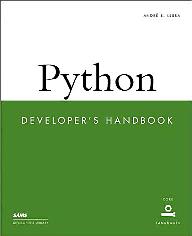Python Developer's Handbook

Author: André S. Lessa
Publisher: SAMS
Price: $44.99 US
ISBN: 0-67231-9942
Reviewer: Phil Hughes
This is one of those rare cases when the book title seems to match the book content. I certainly consider the book a handbook, and it is udoubtedly aimed at developers.
The book is divided into seven parts, each one of which contains from one to five chapters. The parts are titled “Basic Programming”, “Advanced Programming”, “Network Programming”, “Graphical Interfaces”, “Developing with Python”, “Python and Java” and “Appendices”.
Part one is 200 pages long and gets you up and going. After a quick introduction that includes comparative information showing how Python stacks up against C/C++, Perl, Tcl, Smalltalk and Java, the chapters go on to cover the language itself, libraries and exception handling. One particularly good part of this coverage is that functions specific to particular platforms (UNIX, IRIX, Sun OS, MS Windows and Macintosh) are broken out and covered. Even if you only intend to develop for one platform, understanding the specifics of all platforms is useful.
I particularly like the presentation of the material in this part. For example, descriptions of functions include a basic explanation and the syntax but are also generally followed by an example. If the concept is complicated, more space is dedicated to the example.
Part two begins where part one leaves off. It covers “Extending and Embedding Python”, “Objects Interfacing and Distribution”, “Working with Databases” and “Other Advanced Topics”. “Extending” does an excellent job of showing you how to integrate C code with your Python project. Again, liberal use of examples makes everything very clear. “Objects” deals primarily with COM, using examples to keep you on track.
“Databases” covers the use of flat files, DBM, Python's own marshal and shelve, and SQL. This section is fairly short and doesn't go into real detail, but choices such as PostgreSQL, Gadfly and MySQL are introduced, and you are given URLs to find more information. I don't consider this last part a shortcoming of the book as database design and access could (and should) be a book of its own.
“Other Advanced Topics” addresses image manipulation, sound, regular expressions and threads. This chapter has enough information for a serious programmer to get going but could be a little brief for someone new to these concepts. The chapter ends with examples that illustrate the concepts that were presented.
Part three, with over 150 pages, has a lot of meat (tofu?). After a basic introduction to networking that covers HTTP, FTP, SMTP and more, you are off to web development. This chapter covers web server configuration and then goes on to talk about applications such as Zope and Mailman and site management tools. The next chapter is dedicated to scripting and addresses such issues as security, sessions and cookies. The final chapter of part three deals with data manipulation and covers an assortment of topics from XML to PythonPoint.
Part four consists of two chapters. The first chapter introduces graphical interfaces including stdwin, PyKDE, PyGTK and a lot more. The second chapter deals specifically with Tkinter and really gets down to the nuts and bolts.
Part five takes you back from the low-level design stuff and looks at the concepts of development. Again, there is thorough coverage of development strategy, integrated development environments and development and debugging tools on a variety of platforms.
The last body part is on JPython. JPython is a new implementation of the Python interpreter and libraries written in Java. Coverage seems complete.
The final part includes the appendices of the book. The first is documentation on the Python/C API. Coverage is thorough. Next is a chapter on platform specifics. It covers Win32, MacOS, UNIX, OS/2 Windows 3.1, DOS, BeOS, VMS, Psion, Windows CE and even a clue for anything that might have been missed. The final chapter is just the related licenses and copyright information.
Besides covering the language, this book fills in all the blanks. When something is difficult, examples are used to help you out. When the subject is larger than could be covered in this general book, references are given. All in all I found this to be an excellent and accurate book well worth the space it will take on a Python programmer's bookshelf.
Phil Hughes is the publisher of Linux Journal and Embedded Linux Journal.






